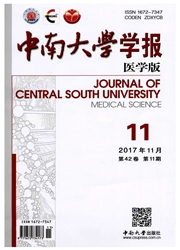

 中文摘要:
中文摘要:
目的:应用速度矢量成像技术(velocity vector imaging, VVI)技术评价正常人群左室扭转一位移环随年龄增长的变化特点,为临床提供评价左心功能的新方法。方法:98例健康志愿者(18~75岁)按年龄分为3组:第1组年龄≤30岁,34例;第2组年龄31-60岁,36例;第3组年龄≥60岁,28例。使用二维超声心动图采集所有受试者左室心尖和心底短轴切面图,VVI软件脱机分析每一切面的左室扭转运动和短轴位移,测量并计算左室扭转角度峰值(peak twist,Ptw)、最大解旋速度(peak untwist velocity, PutwV) 、等容舒张期解旋百分比(the proportion of untwist in isovolumetric relaxation period, Iutw%)、左室径向位移(LV radial displacement, Dis) ,构建扭转一位移环,并比较不同年龄组扭转.位移环的特点。结果:Ptw随年龄增加而增大。PutwV在30~60岁组最大。Iutw%在60岁之前随年龄增加逐渐增大,60岁以后随年龄增加而减小;Dis在3组间的差异无明显统计学意义。左室扭转.位移环的特征象一个“8”字形结构,收缩期的扭转和位移呈线性关系,其斜率随年龄增加而逐渐增大。在舒张早期,伴随解旋出现的径向扩张位移相对较小,导致各组的扭转.位移关系曲线较为陡直,舒张中晚期随着扩张径向位移的逐渐增大,扭转一位移环曲线趋向平坦。结论:VVI能有效、无创地评价左室扭转.位移环随年龄的改变,提供左心功能重要信息;使用扭转.位移环评价左心功能时要考虑年龄的影响。
 英文摘要:
英文摘要:
Objective : To assess effect of age on the characteristic of left ventricular (LV) twist-displacement loop in health volunteers by velocity vector imaging (VVI) and to provide a new method for LV function evaluation in clinic. Methods: After obtaining basal and apical LV short-axis images in 98 healthy volunteers (18-75 years old) by 2-dimensional echocardiography, we use VVI software to analysis LV twist motionand radial displacement at each plane off-line. The peak LV twist (Ptw), the peak untwist velocity (PutwV), the proportion of untwist in isovolumetric relaxation period (Iutw%) and LV radial displacement (Dis) were measured and calculated. Then we constructed LV twist-displacement loop and compared the characteristic of them among different groups. Results: Ptw increased gradually with the increase in age. The biggest PutwV was in the group of 30-60 years old. Iutw% increased gradually before 60 years old, then decreased after that. Dis was not obviously different among the three groups. The characteristic of LV twist-displacement loop was like the configuration of 8. There was a linear relation between twist and displacement during systole, and the slope increased gradually with the increase in age. During early diastole, the relatively small radial expanding displacement displayed with untwisting, resulting in a much steeper twist-displacement relationship curve occurred in each group, which was getting smooth gradually when the radial expanding displacement increased during mid to late diastole. Conclusions: VVI can be used to effectively and noninvasively assess LV twist-displacement loop with change in age and provide important information for LV function. The effect of age must take into account when evaluate the LV function by the twist-displacement loop.
 同期刊论文项目
同期刊论文项目
 同项目期刊论文
同项目期刊论文
 Differences in Left Ventricular Twist Related to Age: Speckle Tracking Echocardiographic Data for He
Differences in Left Ventricular Twist Related to Age: Speckle Tracking Echocardiographic Data for He Quantitative Assessment of Left Ventricular Systolic Function in Patients with Coronary Heart Diseas
Quantitative Assessment of Left Ventricular Systolic Function in Patients with Coronary Heart Diseas Assessment of regional right ventricular longitudinal functions in fetus using velocity vector imagi
Assessment of regional right ventricular longitudinal functions in fetus using velocity vector imagi Assessment of Regional Myocardial Function in Patients with Dilated Cardiomyopathy by Velocity Vecto
Assessment of Regional Myocardial Function in Patients with Dilated Cardiomyopathy by Velocity Vecto 期刊信息
期刊信息
